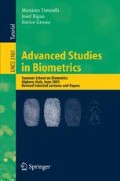Abstract
In this paper a new complete system for 3D face recognition is presented. 3D face recognition presents several advantages against 2D face recognition, as, for example, invariance to illumination conditions. The proposed system makes use of a stereo methodology, that does not require any expensive range sensors. The 3D image of the face is modelled using Multilevel B-Splines coefficients, that are classified using Support Vector Machines. Preliminary experimental evaluation has produced encouraging results, making the proposed system a promising low cost 3D face recognition system.
Access this chapter
Tax calculation will be finalised at checkout
Purchases are for personal use only
Preview
Unable to display preview. Download preview PDF.
References
Chellappa, R., Wilson, C., Sirohey, S.: Human and machine recognition of faces: a survey. Proceedings of IEEE 83, 705–740 (1995)
Ming-Hsuan, Y., Kriegman, D., Ahuja, N.: Detecting faces in images: a survey. IEEE Trans. on Pattern Analysis and Machine Intelligence 24, 34–58 (2002)
Ho-Chao, H., Ming, O., Wu, J.L.: Automatic feature point extraction on a human face in model-based image coding. Optical Engineering 32, 1571–1580 (1993)
Lapresté, J., Cartoux, J., Richetin, M.: Face recognition from range data by structural analysis. In: Syntactic and Structural Pattern Recognition. NATO ASI Series, pp. 303–314 (1988)
Gordon, G.: Face Recognition from depth and curvature. PhD thesis, Harvard University (1991)
Gordon, G.: Face recognition based on depth and curvature features. In: Proc. of Int. Conf. on Computer Vision and Pattern Recognition, pp. 808–810 (1992)
Achermann, B., Jiang, X., Bunke, H.: Face recognition using range images. In: Proc. of Int. Conf. on Virtual Systems and MultiMedia, pp. 129–136 (1997)
Achermann, B.: Face recognition using range images. PhD thesis, Institute of Computer Science and Applied Mathematics, University of Bern (1998)
Achermann, B., Bunke, H.: Classifying range images of human faces with hausdorff distance. In: Proc. of Int. Conf. on Pattern Recognition, vol. 2, pp. 809–813 (2000)
Dhond, U.R., Aggarwal, J.K.: Structure from stereo – a review. IEEE Trans. on System Man and Cybernetics 19, 1489–1510 (1989)
Lee, S., Wolberg, G., Shin, S.Y.: Scattered data interpolation with multilevel bsplines. IEEE Trans. on Visualization and Computer Graphics 3, 228–244 (1997)
Burges, C.: A tutorial on support vector machine for pattern recognition. Data Mining and Knowledge Discovery 2, 121–167 (1998)
Pontil, M., Verri, A.: Support vector machines for 3-d object recognition. IEEE Trans. on Pattern Analysis and Machine Intelligence 20, 637–646 (1998)
Bicego, M., Iacono, G., Murino, V.: Face recognition with multilevel b-splines and support vector machines. In: Proc. of ACM SIGMM Multimedia Biometrics Methods and Applications Workshop (2003)
Zhang, Z.: Flexible camera calibration by viewing a plane from unknown orientations. In: Proc. of Int. Conf. on Computer Vision, Corfu, Greece (1999)
Fusiello, A., Trucco, E., Verri, A.: A compact algorithm for rectification of stereo pairs. Machine Vision and Applications 12, 16–22 (2000)
Fusiello, A., Castellani, U., Murino, V.: Relaxing symmetric multiple windows stereo using markov random fields. In: Figueiredo, M., Zerubia, J., Jain, A.K. (eds.) EMMCVPR 2001. LNCS, vol. 2134, pp. 91–104. Springer, Heidelberg (2001)
Trucco, E., Verri, A.: Introductory Techniques for 3-D Computer Vision. Prentice-Hall, Englewood Cliffs (1998)
Guo, G., Li, S.Z., Kapluk, C.: Face recognition by support vector machines. Image and Vision Computing 19, 631–638 (2001)
Vapnik, V.: The Nature of Statistical Learning Theory. Springer, Heidelberg (1995)
Author information
Authors and Affiliations
Editor information
Editors and Affiliations
Rights and permissions
Copyright information
© 2005 Springer-Verlag Berlin Heidelberg
About this chapter
Cite this chapter
Castellani, U., Bicego, M., Iacono, G., Murino, V. (2005). 3D Face Recognition Using Stereoscopic Vision. In: Tistarelli, M., Bigun, J., Grosso, E. (eds) Advanced Studies in Biometrics. Lecture Notes in Computer Science, vol 3161. Springer, Berlin, Heidelberg. https://doi.org/10.1007/11493648_8
Download citation
DOI: https://doi.org/10.1007/11493648_8
Publisher Name: Springer, Berlin, Heidelberg
Print ISBN: 978-3-540-26204-6
Online ISBN: 978-3-540-28638-7
eBook Packages: Computer ScienceComputer Science (R0)

